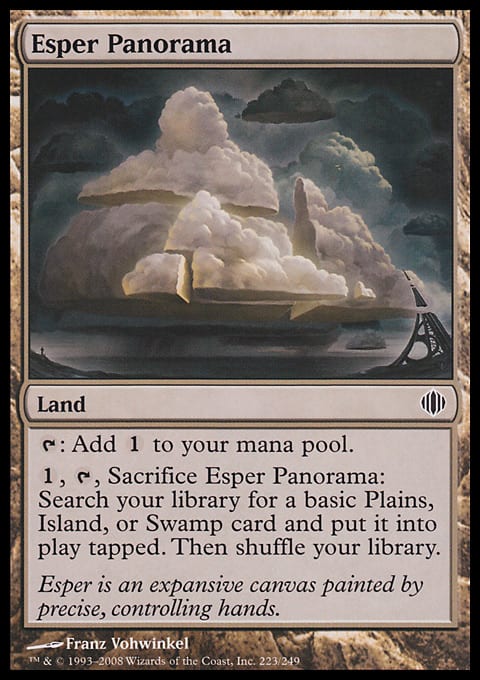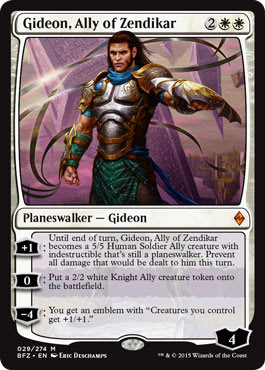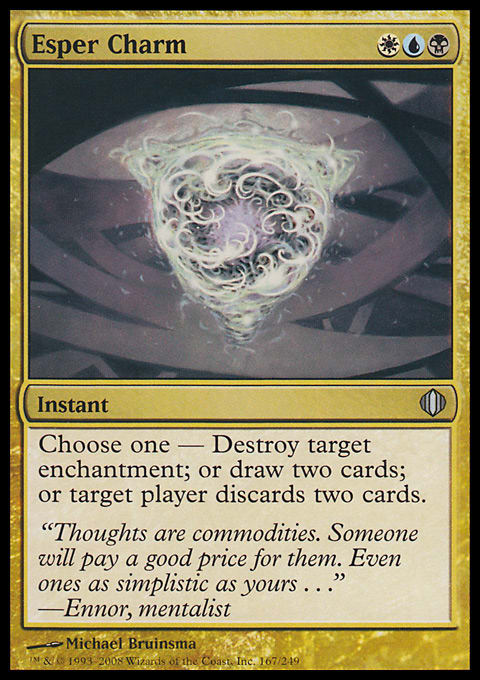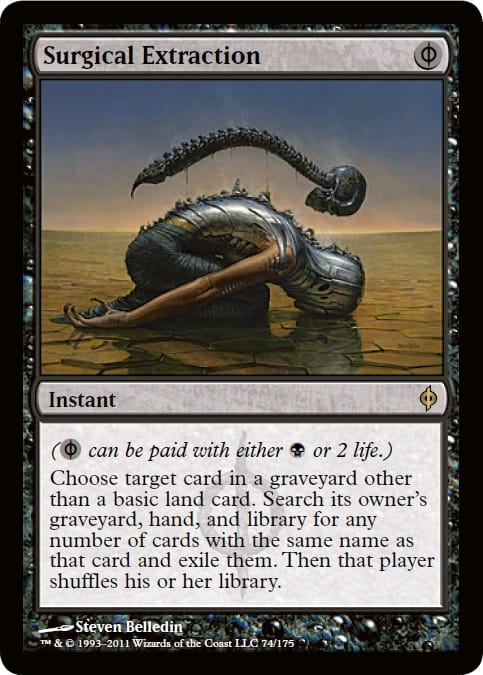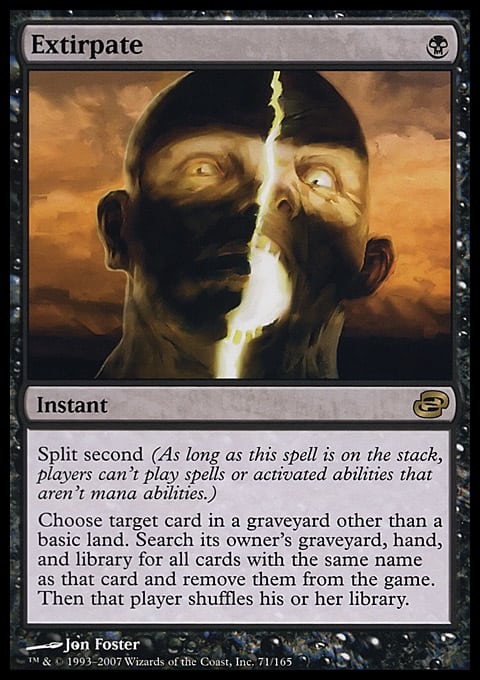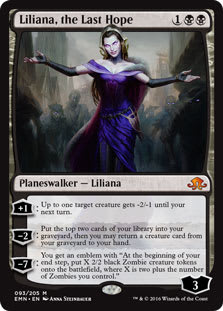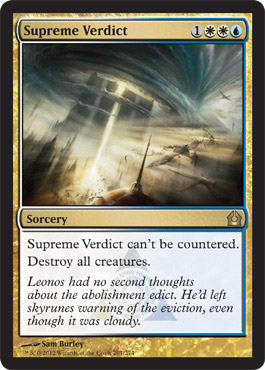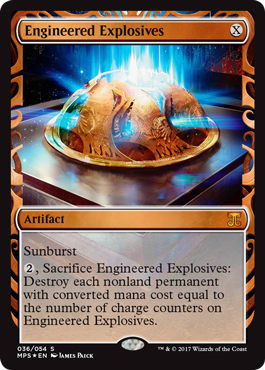I’ve tried my hand in Control decks in Modern and I’ve found them a bit lacking. It could be because I’m so used to playing “draw go” as my control decks. I’m old when it comes to Magic terms. When people say a deck is “control” in Standard it just looks like a pile of Midrange cards with a couple of counterspells to me. Sometimes the decks don’t even run counter magic at all and are listed as “control.” Things like B/G Control, B/W Control, and even R/W Control have popped up and they just don’t look like true control decks to me. So today I’ve contacted a friend of mine, Francesco Amati, who is a big advocate for control decks in Modern, notably in U/W and Esper. He is the courier of Esper control and a lot of people look up to him in that community. He’s logged countless matches online and locally with the deck and has had his followers and friends play the deck so they could improve and make it the best control deck possible. Today I’m going to interview Francesco Amati and we are going to talk about his control deck and why it’s a good choice to pick up. My eyes see control in an old light, Francesco is new blood, he isn’t tainted by the past and he sees things through a different lens than I do, and I value his opinions when it comes to this archetype. So, if you’re a big lover of control in Modern, this article is going to be great for you!
Let’s get to know Francesco a little bit before we dive into everything.
How long have you been playing Magic for, what drove you to control decks and why Modern?
I’ve been playing Magic for almost eight years (2009). What drove me to Control was my transition from the Pokemon trading card game that I played for 10+ years. I used to play a Psychic deck that focused on disrupting my opponent’s gameplan, leaving them with minimal resources, followed by stabilization and pressure that made it difficult for opposing decks to play against. This style appeals to me and is the reason I’ve stuck to the Control archetype in Magic.
Philosophically, on a more profound level, the archetype and colors, U/W and Esper, represent a reflection and extension of who I am.

We see this from other players like Craig Wescoe (Hatebears), Shaun McLaren (UWR Control), and Wafo Tapa (Esper Draw Go), to name a few. It’s their identity. This is mine.
I prefer Modern because it’s a format that allows me to play some of my favorite cards since I first started playing in 2009. I’ve grown with, and know, the format well, so it has a sentimental value to me.
You’ve cultivated a following for yourself and people look up to you when it comes to U/W and Esper decks, why do you think that is?
I value the community aspect of the game. I have several communities on Facebook to express and share my passion for my interests — to give people an outlet to express and share theirs, too. This passion and enthusiasm seems to rub off on others. I get this feedback from my friends, family, and co-workers, so I can only assume the same holds true for players who share my interest in U/W and Esper, or Control, in general.
Being a meta player who approaches the archetype from my perspectives, which are typically predicated on deep meta analysis and learning how other decks function (which correlates with the way my decks are decks), can be intriguing and inspiring to players. I’m not always on point, but I’m confident with my grasp on the format.
What’s your favorite control deck of all time?
That would have to be Caw-Blade with Squadron Hawk, Stoneforge Mystic, Jace, the Mind Sculptor, and Gideon Jura. Now it’s this Esper deck.
If you could design any control card that you think is fair, what card what that be for Modern?
Intrude
![]()
![]()
Instant
Target player reveals his or her hand. You choose a nonland card from it. That player puts that card at the bottom of their library. You draw a card.
It’s sort of like a Vendilion Clique on a spell, but with cantrip built in for its controller.
You’re the creator of Esper Twix, a deck that utilizes cheap creatures and cheap spells to tempo and disrupt the opponent out of the game. You’ve opted to go bigger in your new deck, why is that?
Esper Control is in some ways a successor to that deck. It’s similar in principle, but it’s a lot more resilient to removal and its versatile design gives it ample reach against more decks across the field. Twix struggled against Burn, creature strategies, and BGx. This deck is better against each, especially BGx, but is also good against Combo and Control.
This deck is a proactive Esper Walkers Control deck that takes advantage of Narset Transcendent, but is also designed to be heavily disruptive, synergistic, resilient, and versatile. The deck is comprised of many cross-performing and multi-functional cards (a.k.a. Modal Spells), with intricate interactions and unique lines of play, that allow the player to navigate from various angles.
The decks general concept is to control the game through significant hand, battlefield, graveyard, and deck disruption, while generating value, stabilization, and pressure via Snapcaster Mage, Lingering Souls, Esper Charm, and Planeswalkers.
To give you some MU ratios, the deck is 70/30 vs Junk/Jund, 60/40 vs Infect, Affinity, Zooicide, and several others. It even has game against Bant Eldrazi and has improved against Tron. This the first time I’ve experienced these ratios across a variety of different competitive archetypes since playing in this format with UWx control deck.
Awesome, thank you Francesco, speaking of the deck, let’s have a look at it!
Esper Control (Esper Transcendent) ? Modern| Franceso Amati
- Creatures (3)
- 3 Snapcaster Mage
- Planeswalkers (7)
- 1 Gideon Jura
- 1 Sorin, Solemn Visitor
- 2 Gideon, Ally of Zendikar
- 3 Narset Transcendent
- Instants (10)
- 2 Blessed Alliance
- 4 Esper Charm
- 4 Path to Exile
- Sorceries (16)
- 3 Inquisition of Kozilek
- 3 Serum Visions
- 3 Supreme Verdict
- 3 Thoughtseize
- 4 Lingering Souls
- Lands (24)
- 1 Swamp
- 2 Island
- 2 Plains
- 1 Godless Shrine
- 1 Watery Grave
- 2 Celestial Colonnade
- 2 Concealed Courtyard
- 2 Flooded Strand
- 2 Ghost Quarter
- 2 Hallowed Fountain
- 2 Marsh Flats
- 2 Shambling Vent
- 3 Polluted Delta
- Sideboard (15)
- 1 Celestial Purge
- 2 Collective Brutality
- 3 Countersquall
- 1 Disenchant
- 1 Elspeth, Knight-Errant
- 1 Engineered Explosives
- 1 Extirpate
- 3 Geist of Saint Traft
- 2 Surgical Extraction
See, this is what I’m talking about. I have historically built my control decks in Modern with Cryptic Command in mind. I have a hard time not playing that card alongside Snapcaster Mage, I believe it’s one of the better cards to run in Blue decks. However, Francesco has opted to run zero Cryptic Commands in favor of Planeswalkers, even playing the dominating planeswalker in Standard, Gideon, Ally of Zendikar. Francesco obviously believes that Gideon is stronger than Elspeth, Knight-Errant and I can’t disagree. 2/2s are 100% bigger than 1/1s and while Elspeth can close the game fast with her jump ability, she still can’t close the game as quickly as Gideon can. Especially since Elspeth needs a creature in play to jump where Gideon needs nothing else, he also happens to work fantastically with Supreme Verdict.
What’s even better is that Gideon, Ally of Zendikar has an ultimate that you can use right away unlike Elsepth. This makes Lingering Souls a true beating. 5 mana for 8 power and toughness in the air can and will close out any game fast. Even if you have a Gideon Jura you need to cast next turn, you can emblem your current Gideon then play your Gideon Jura and start upticking him without losing having to lose your previous Planeswalker. Francesco’s deck seems to have come to a great balance. It’s capable of doing a lot, but consistently and cohesively. It has cards that will gain you life, Planeswalkers that continuously put tokens onto the battlefield, and the ability to slow the pace by playing defensively or turn the corner by pressuring with a respectable clock from various angles between main and side. These tokens, for instance, will buy you time until you can take over the game or just kill your opponent by making an army of tokens. Unlike traditional control decks, this one is extremely proactive and aggressive.
If you look closely you’ll notice, we have zero counter spells in the main deck. This makes the deck never miss a beat by having to hold up countermagic. You’d think it would be weak to combo decks, but it’s not. Six 1 mana discard spells are a great way to make your combo opponent stumble. You can even finish off their hand by making them discard two cards with Esper Charm. You can then flashback Esper Charm with Snapcaster Mage or even set it up with Narset Transcendent. This will force your opponent to play out their hand or risk having to discard it with the rebound ability. Even if they do play out their hand to play around the discard, you can then just opt to draw two cards instead when Esper Charm is rebounded. This can be crippling to many decks, especially those that mostly play at Sorcery speed. Narset is a huge reason to not play cards like Mana Leak since they don’t play well with her minus two ability. Every other spell works fine to game breaking.
The deck obviously has many hours put into it, you can tell this by just looking at the deck and the numbers that were chosen. That being said, let’s ask Francesco a few questions on the deck.
I see you’re not running any Rest in Peace. Are the Surgical Extractions and Extirpate just better since you can bring them in against other matchups?
Indeed. They’re a core element of this deck’s design and gameplan, especially to capitalize on our disruption plan. It’s how we often navigate against Combo/Control decks, including Tron. We level the playing field by stripping away their best cards that either position them to win or generate value. We also want less cards susceptible to removal, which is why you don’t see Stony Silence either, but always an option if you’re inclined.
Deck looks great and I see that you’re trying to be proactive, but have you considered a card like Liliana, the Last Hope? You can protect her well and re-buying Snapcaster Mages seems decent if the game goes long.
I haven’t considered her actually as I even opted away from playing Liliana of the Veil, but the Last Hope seems interesting. It may be worth testing. Thanks! I also appreciate the compliment. It’s the most passion and work I’ve ever dedicated to a deck. It’s been a grueling process, but very gratifying, especially seeing the feedback from other players playing it.
What are the decks good matchups?
It has many good matchups, some of which I posted above. Darrel Feltner, known as Bigdeezyrider on MTGO, recently went 5-0 in a Competitive MTGO League and has logged in over 100 games (in a spreadsheet) there. He’s averaging around a 60% win percentage (about the same any Tier 1 deck). You can catch many games on his Twitch stream.
What matchups does the deck want to dodge?
Dredge (even though we can stall well to eventually stabilize and can get lucky with Extractions + Snap/Extractions). The other used to be Tron, but it’s gotten better. It comes down to its Sideboard configuration, which can be tailored to suit one’s meta and preference. A particular Matchup that I personally despise is Elves, even though it isn’t Tier 1. Historically, that’s my worst matchup, especially while I played U/W. It’s manageable, even winnable, but annoying because they can be absurdly explosive, especially the version with Beck // Call. Supreme Verdict and Engineered Explosives go a long way to beating that deck though.
Why would you recommend people to play this deck?
I’d recommend this deck to people who want to play a different brand of Control in Modern, but who especially value a proactive strategy (like in BGx) and want a flexible/versatile Control deck that is designed to be viable vs various archetypes and adaptable against any meta.
Well, there you have it folks. Thank you, Francesco, for your time and effort, is there anything else you’d like to say?
As the deck's designer, it’s important for me to present the most focused version/core of this deck that best represents its concept and gameplan. Then players can tweak it for meta calls and personal preferences, but it’s important not to stray too far from the main deck’s core design (there’s about 4, maybe flex spots). It’s a complex deck, but fun, competitive, and rewarding to master. It’s like a puzzle — eventually, the pieces fit and fit with accuracy if you know what you’re doing.
For more on this deck’s development, you can keep up with it on Tappedout.
Keep these things in mind while playing.
- Be versatile and adaptable to the flow of the game.
- Play as though you're already ahead/winning by playing in reverse and visualizing the end-game.
- Put your opponent in a position to misplay, be left with minimal resources, and lose.
- Understand the game and your deck on a deeper level through meta analysis, such as finding common principles and patterns across the format.
This is why I love the complexity of this deck. Your investment is rewarded beyond just winning, but by also becoming a better player and student of the game.
Thanks again Francesco!
I know we have players really wanting to play Control in Modern. If so, you should give this deck a whirl! Thank you Francesco for all the time and effort you’ve put into this. If you folks have any questions about the deck or for Francesco I’m sure he’ll be looking at the comments so make sure to ask them!
As always, thanks for reading
Ali Aintrazi
@Alieldrazi on Twitter















